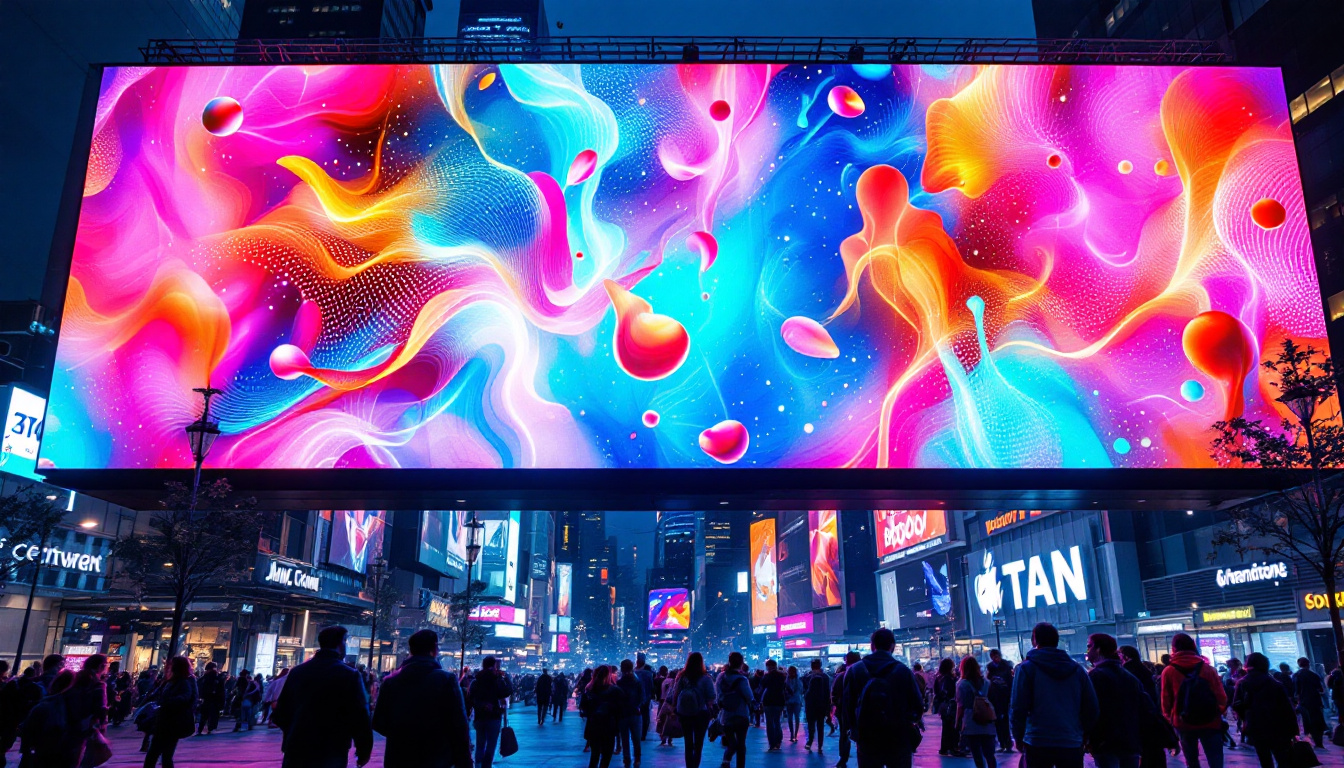In the realm of modern technology, displays play a pivotal role in how we interact with devices. Two of the most common types of displays are LCD (Liquid Crystal Display) and LED (Light Emitting Diode). While they are often mentioned in the same breath, they serve different purposes and operate on distinct principles. This article aims to clarify the differences, functionalities, and applications of LCD boards and LED displays, providing a comprehensive understanding of each.
Understanding LCD Technology
Liquid Crystal Displays (LCDs) have become ubiquitous in various devices, from televisions to smartphones. Their ability to produce vibrant images while consuming less power than traditional cathode ray tube (CRT) displays has made them a popular choice in the consumer electronics market. As technology has progressed, LCDs have evolved, leading to innovations such as high-definition (HD) and ultra-high-definition (UHD) displays, which offer even sharper images and more detailed visuals. This evolution has not only enhanced the viewing experience but has also made LCDs a staple in professional settings, such as graphic design and video editing, where color accuracy is paramount.
How LCDs Work
At the core of an LCD is a liquid crystal solution sandwiched between two polarizing filters. When an electric current passes through the liquid crystals, they align in a way that allows light to pass through or be blocked. This manipulation of light creates the images seen on the screen. The backlight, typically provided by fluorescent lamps or LEDs, illuminates the display, allowing the colors to be visible. The advancements in LED backlighting, particularly with the introduction of edge-lit and full-array local dimming technologies, have further improved contrast ratios and brightness levels, enhancing the overall picture quality.
The color reproduction in an LCD is achieved through a combination of red, green, and blue (RGB) sub-pixels. By adjusting the intensity of each sub-pixel, a wide range of colors can be produced, resulting in the rich visuals that users have come to expect. Moreover, the introduction of technologies like In-Plane Switching (IPS) and Vertical Alignment (VA) has allowed for better color accuracy and wider viewing angles, making LCDs suitable for collaborative environments where multiple viewers may be watching from different angles.
Advantages of LCD Displays
One of the primary advantages of LCD technology is its energy efficiency. Compared to older display technologies, LCDs consume significantly less power, making them ideal for portable devices. Additionally, they are lightweight and thin, allowing for sleek designs in laptops and smartphones. This portability has revolutionized how we interact with technology, enabling users to enjoy high-quality displays on the go, whether for gaming, streaming, or productivity tasks.
Furthermore, LCDs provide excellent image clarity and sharpness. They are less prone to burn-in compared to plasma displays, and their flat panel design allows for wider viewing angles without significant color distortion. The durability of LCDs also contributes to their popularity; they are generally more resistant to physical damage than older technologies, which makes them a preferred choice for public displays and signage. As manufacturers continue to innovate, we can expect even more enhancements in terms of resolution, refresh rates, and adaptive technologies that cater to diverse user needs and preferences.
Exploring LED Displays
Light Emitting Diode (LED) displays have gained immense popularity in recent years, particularly in large-scale applications such as billboards and sports arenas. Unlike traditional LCDs, which rely on a backlight, LED displays use individual diodes to emit light, resulting in brighter images and more vibrant colors. This shift in technology has not only transformed the way we experience visual media but has also opened up new avenues for artistic expression and advertising innovation.
How LED Displays Function
LED displays can be categorized into two main types: direct view and backlit. Direct view LED displays consist of numerous tiny LEDs that create the image directly. Each pixel in an LED display is made up of red, green, and blue LEDs, which can be controlled independently to produce a full spectrum of colors. This capability allows for dynamic content that can change in real-time, making them particularly effective for live events and interactive installations.
On the other hand, backlit LED displays are essentially LCDs that use LEDs as a backlight instead of traditional fluorescent lamps. This technology enhances the brightness and contrast of the images displayed, leading to improved picture quality. The combination of LED backlighting with high-definition LCD panels has resulted in displays that not only look stunning but also consume less power, making them an environmentally friendly choice for consumers and businesses alike.
Benefits of LED Technology
One of the most significant advantages of LED displays is their brightness. They can produce images that are easily visible even in bright daylight, making them ideal for outdoor applications. Additionally, LED displays have a longer lifespan compared to traditional LCDs, reducing the need for frequent replacements. This durability is particularly beneficial for businesses that rely on continuous operation, as it minimizes downtime and maintenance costs.
Moreover, LED technology is highly versatile. It can be used in various formats, including flexible displays and large video walls, providing endless possibilities for creative applications in advertising and entertainment. For instance, flexible LED screens can be curved or shaped to fit unique architectural designs, allowing brands to create immersive experiences that captivate audiences. Furthermore, the rapid advancements in LED technology have led to the development of high-resolution displays that can deliver stunning visuals, making them a preferred choice for everything from concerts to corporate presentations.
Comparing LCD and LED Displays
While both LCD and LED displays have their unique advantages, understanding their differences is crucial for making informed decisions when selecting a display for specific applications.
Image Quality
When it comes to image quality, LED displays generally outperform LCDs. The ability of LEDs to produce deeper blacks and brighter whites results in higher contrast ratios. This is particularly noticeable in dynamic scenes, where LED displays excel in rendering fast-moving images without blurring.
However, high-quality LCDs can still deliver impressive visuals, especially those utilizing advanced technologies like In-Plane Switching (IPS) or Vertical Alignment (VA), which enhance color accuracy and viewing angles.
Energy Consumption
Energy efficiency is another area where LCDs tend to have an edge, especially in smaller devices. While LED displays are more efficient than traditional CRTs, they can consume more power than LCDs, particularly when displaying bright images. However, advancements in LED technology have led to more energy-efficient models that can rival LCDs in this regard.
Cost Considerations
Cost is often a deciding factor when choosing between LCD and LED displays. Generally, LCDs are more affordable than their LED counterparts, making them a popular choice for budget-conscious consumers. However, the price gap has been narrowing as LED technology becomes more mainstream and production costs decrease.
Applications of LCD and LED Displays
The applications of LCD and LED displays are vast and varied, each serving different sectors and needs. Understanding where each type excels can help in choosing the right display for specific requirements.
LCD Applications
LCDs are commonly found in devices such as televisions, computer monitors, and mobile phones. Their ability to deliver high-resolution images makes them ideal for gaming and graphic design applications. Additionally, LCDs are widely used in medical devices, where precise imaging is critical for diagnostics.
In the automotive industry, LCD displays are increasingly used in dashboards and infotainment systems, providing drivers with essential information in a clear and concise manner.
LED Applications
LED displays shine in outdoor advertising, where visibility is paramount. Billboards and signage that utilize LED technology can capture the attention of passersby with bright, dynamic content. Furthermore, LED displays are becoming increasingly popular in sports arenas, providing spectators with real-time updates and highlights.
In the realm of entertainment, LED screens are used for concerts and events, creating immersive experiences with vibrant visuals. Their flexibility allows for creative installations that were previously impossible with traditional display technologies.
Future Trends in Display Technology
The world of display technology is continually evolving, with innovations that promise to enhance both LCD and LED displays. As consumer demands for higher quality visuals and energy efficiency grow, manufacturers are investing in research and development to push the boundaries of what is possible.
Advancements in LCD Technology
One of the most promising advancements in LCD technology is the development of Mini-LED and Micro-LED displays. These technologies utilize smaller LEDs to enhance backlighting in LCDs, resulting in improved contrast ratios and color accuracy. Mini-LEDs can provide localized dimming, allowing for deeper blacks and brighter highlights, which significantly enhances the viewing experience.
Additionally, the integration of quantum dot technology is set to revolutionize LCDs. Quantum dots can produce more vibrant colors and improve overall picture quality, making them a formidable competitor against traditional LED displays.
Emerging LED Technologies
On the LED front, the rise of OLED (Organic Light Emitting Diode) technology is noteworthy. OLED displays eliminate the need for a backlight by using organic compounds that emit light when an electric current is applied. This results in thinner displays with better contrast ratios and color accuracy.
Furthermore, advancements in flexible LED technology are paving the way for innovative applications. Flexible displays can be bent and shaped, allowing for new design possibilities in consumer electronics, fashion, and architecture.
Conclusion
In summary, both LCD and LED displays have their unique strengths and applications. Understanding the fundamental differences between these technologies is essential for making informed choices in today’s tech-driven world. As advancements continue to emerge, the future of display technology promises even more exciting developments, making it an area to watch closely.
Whether it’s for personal use, business applications, or large-scale advertising, the choice between LCD and LED will ultimately depend on specific needs, budget, and desired visual quality. As technology progresses, consumers can expect even more innovative and efficient display solutions that enhance their viewing experiences.
Discover Cutting-Edge LED Displays with LumenMatrix
Ready to elevate your visual experience with the latest in LED display technology? Look no further than LumenMatrix, a leader in innovative LED solutions. From captivating Indoor and Outdoor LED Wall Displays to dynamic Vehicle and Sports LED Displays, LumenMatrix offers a wide array of products designed to enhance brand visibility and audience engagement. Whether you need a Custom LED Display, an All-in-One solution, or a striking LED Transparent Display, LumenMatrix has the expertise to bring your vision to life. Check out LumenMatrix LED Display Solutions today and see how they can transform your visual communication with clarity and impact.































